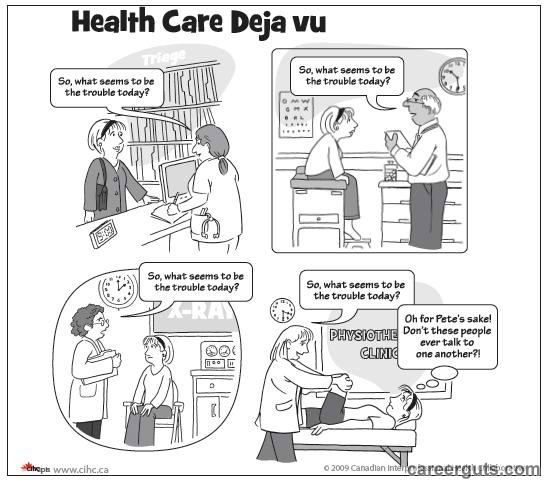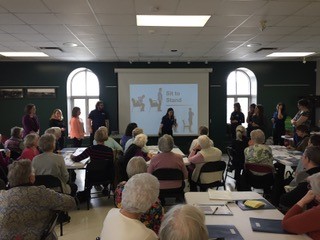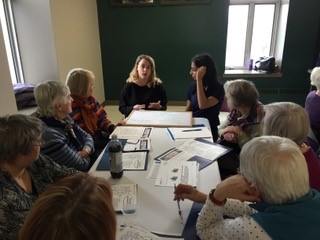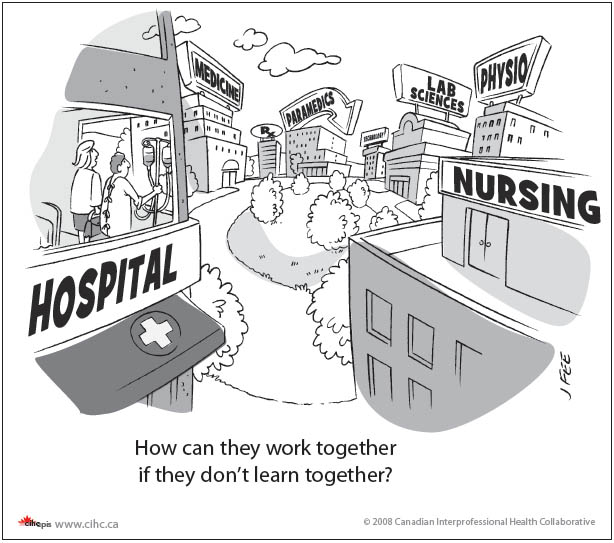Team: a collection of people working together for a common goal. It says so in the word itself: Together Everyone Achieves More.
Team: a word that can bring on a multitude of different feelings depending on the experience. Whether on a field or a rink, in a classroom or a meeting room, in a hospital or walk-in-clinic, there can be many good, bad, wonderful or dreadful experiences when working in a team. It is safe to say that the best teams strive for the best outcomes using the most efficient strategies. Even when the goals are not achieved, other unexpected benefits often result from the process and, at the very least, lessons are learned that help propel the team forward.
Team: a word that can trigger memories of prior successful collaborations. For example, a team of ghost-fighting heroes, including Dan Aykroyd and Bill Murray, in the 1984 classic movie, Ghostbusters. Or Team Canada’s women’s hockey team that won gold in the 2014 Sochi Olympic Games, with a game-winning goal scored by Dawson alumna, Marie-Philip Poulin. Or, even the team of an estimated 400,000 scientists, engineers, and technicians who helped Apollo 11 land on the moon in 1969. Whether fact or fiction, some impressive teams have demonstrated what it takes to achieve a common goal.
Team, finally, is a word that encapsulates the types of relationships being formed within the medical and health-related programs at Dawson College. The six programs, consisting of Biomedical Laboratory Technology, Diagnostic Imaging, Nursing, Physiotherapy Technology, Radiation Oncology and Social Service, have been working together over the past year to implement an Interprofessional Education (IPE) approach.
Interprofessional collaboration and education
To fully understand the IPE approach, it was important to research and understand the fundamentals of Interprofessional Collaboration (IPC). The literature describes IPC as “…the process of developing and maintaining effective interprofessional working relationships with learners, practitioners, patients/clients/families, and communities to enable optimal health outcomes. Elements of collaboration include respect, trust, shared decision making, and partnerships.”[1] What really intrigued us was that IPC demonstrated many benefits, including enhanced patient care and patient outcomes, and, for clinicians, lower stress levels and greater job satisfaction.[2]
Further, we found that IPC can be achieved through the coordinated implementation of Interprofessional Education. IPE happens when two or more students within a medical career program learn with, from, and about each other to improve the quality of patient, or client, care.[3] Research demonstrates that effective collaboration among different health care specialists is essential for the existence and persistence of an all-encompassing and comprehensive health care approach.[4] Across the literature, a clear theme emerged, “that a successful experience among any IPE activity allows students to understand their own professional identity while gaining an understanding of other professionals’ roles on the health care team.”[5]

Now, you are probably thinking, doesn’t this just mean interdisciplinary education? Although the two approaches are quite similar, there is one major difference, that is, the relationships created in IPE. Whereas a discipline is an academic division of knowledge, a profession is a practical occupation, vocation, or career that requires special education. In this respect, interdisciplinary means the interaction between disciplines in order to gather information, work together, and solve a problem. An interprofessional approach, on the other hand, is truly the relationship that is created among its users. The purpose of an interprofessional approach is still to interact and work toward a common goal but, when the common goal is the health of the patient, a relationship between professions is critical and needs to be formed. In addition, the word interprofessional can be used to describe the specific overlaps between the professions with the aim of aiding the patient. While interdisciplinary approaches are widely used across the CEGEP network, interprofessional approaches are not, at least not yet.
Testing some IPE activities
Over the past year, the six medical and health-related programs have been developing a wide variety of IPE activities. An important lesson we learned early on was to start with what made sense and begin with low-barrier and low-risk activities to minimize disruptions to what is already working. It became evident that Physiotherapy Technology, Social Service, and Nursing have a more favourable pace to their day-to-day operations. These three programs have been the test programs, but the goal for the next few years is to increase the number of IPE activities and extend their reach into more programs.
Learning in the flesh
Using cadavers at the Concordia University Exercise Science lab, students from the Physiotherapy Technology program taught Nursing students about the muscular and nervous systems, while the nursing students taught the physiotherapy students about the cardiovascular, respiratory and digestive systems. Employing active learning strategies such as jigsaw and toolkit, the students were able to exchange with one another and reflect on some key takeaways from the activity. There were definitely some “aha” moments for both groups as they were able to see, literally in the flesh, the joint articulations, angles of pull, and tissue orientation and texture that they had been learning about throughout their education.
 Student retention through fall prevention
Student retention through fall prevention
For many people living in the regions of Quebec, access to healthcare services in English is extremely difficult. With Health Canada funding, accessed by way of Dialogue McGill, professors from the Physiotherapy Technology program, Vanessa Gangai and Alison Gelinas, have been working to change this reality. Their IPE project, “Student retention through fall prevention,” seeks both to recruit Eastern Townships students to study at one of Dawson’s medical and health-related programs and to provide health information in English to seniors living in the Eastern Township communities.
Helga Tonkoz, a student in Physiotherapy Technology
Phase one of the project took place during the winter semester and brought together eleven bilingual Physiotherapy Technology and Social Service students to create and present two outreach workshops. These highly interactive and well-received workshops were given in Lennoxville, Quebec, and involved 120 prospective high school students and 49 local seniors. The full-day education and recruitment trip also included visits to a potential healthcare employment institution and points of interest in the region. The next phase of the project will target a different Eastern Townships community and hopes to include more specialties from among Dawson’s medical and health-related programs. Video footage of the initiative will be shared with the Dawson community in the fall semester to highlight the shortage of English healthcare services in the regions and potentially attract graduates to seek employment in these areas.
Role clarification through workplace simulations
Students from Physiotherapy Technology and Social Service also participated in two interprofessional simulation activities on role clarification in the workplace. In the larger of the two workshops, using four different patient cases, 60 students worked in small heterogeneous teams to create and execute the intervention procedure. With the use of active learning strategies like peer instruction and jigsaw, the students were able to learn with, from, and about each other through this high-paced yet focused workshop. Feedback from the group was extremely positive. A student from the Social Service program stated that the activity allowed her to realize that “no matter what the helping profession, the goal remains helping people and the more we work together, the more we can be of help.” Another Social Service student added that she “enjoyed the teamwork aspect. We most likely will never work on our own, thus learning to work as a team is essential.”
Day-in-the-life documentaries
In another activity, using a GoPro purchased with a 2019 SALTISE mini-grant, students within the Social Service and Physiotherapy Technology programs documented a day in the life of a student within their respective programs. An interprofessional activity is being created to allow for other medical and health-related programs to create similar footage, which will then be used to help all students learn about each other’s programs.
The IPE team is working on using Logitech Rally Ultra HD cameras and the videoconferencing software Zoom, to complete more interprofessional simulation activities in any type of physical space. Whether the learning environment is a simulated hospital room or a patient’s apartment, the plan is to have a small group of students complete the simulation while the rest of the class watches from an adjacent room. The hope is that through filming the session, students will learn from both what they did well and from their mistakes. Also, students watching the intervention will be able to discuss freely their colleagues’ performance.
Lessons learned
Over the past year, the IPE team has learned a lot. Over the course of many meetings, e-mails, phone calls, workshops, and hallway conversations, we have learned to work more closely by exchanging ideas, strategies, and best practices. In the process, we have learned that it is not easy to implement change across multiple programs, especially when trying to add another layer to our teaching practice. We would like to share three key lessons we have learned so far, in case other groups are attempting a similar type of project.
1) Listen, empathetically. When trying to build relationships across teams, it is critical to listen to  people and try to put yourself in their shoes. Each of the six medical and health-related programs has a different day-to-day life. Some have more theory-focused competencies where every minute of every course is calculated for every topic. Some have more practice-based competencies where conversation is their theory. While some programs are going through revision, others are settling into their new home in the Forum. All these differences and constraints can slow down anything new and non-critical. Yet, it is by listening to each other that we have been able to reach the level of teamwork we have achieved to date.
people and try to put yourself in their shoes. Each of the six medical and health-related programs has a different day-to-day life. Some have more theory-focused competencies where every minute of every course is calculated for every topic. Some have more practice-based competencies where conversation is their theory. While some programs are going through revision, others are settling into their new home in the Forum. All these differences and constraints can slow down anything new and non-critical. Yet, it is by listening to each other that we have been able to reach the level of teamwork we have achieved to date.
2) Slow is good. In the adoption of something new, we knew that starting off with a bang could make even a good idea fail. In order to gain and maintain momentum, we decided that change has to occur gradually and naturally so that everyone has a chance to go through their process, at their pace.
3) Try what makes sense. At the beginning, we knew we had a steep road ahead. One thing that helped was to start by giving ourselves a pat on the back and acknowledging what we do well. Each program was already completing many intraprofessional activities, that is, each program was putting its students through the paces of simulation and/or practical learning. As the literature has shown, this is quite effective in teaching a practical skill. If these types of activities were already happening, then maybe it wouldn’t be too difficult to add another group to the mix. If there were low-barrier and low-risk ideas or initiatives that came up, we went for them. Our credo was that we would never know if something would work until we tried it. And sometimes, the best thing you can do is fail.
Overall, the momentum generated within the medical and health-related programs in the development of an interprofessional education approach is right where it should be: in the hands of the users. While the process has been new for everyone, the key success factor in our work has been staying true to our individual needs and trying to do the best for our students by incorporating the low-barrier, low-risk activities all the while working in collaboration with each other, as a team. We may not be busting ghosts, winning gold medals, or flying to the moon, but with a little luck and a lot of hard work, our team is making incremental changes to our programs in order for our students to learn with, from, and about each other, and improve the quality of care.
Footnotes
[1] Canadian Interprofessional Health Collaborative (CIHC), Knowledge transfer & exchange in interprofessional education: synthesizing the evidence to foster evidence-based decision-making, 2008.
[2] World Health Organization (WHO), “Framework for action on interprofessional education and collaborative practice” (2010), www.who.int/hrh/resources/framework_action/en/.
[3] WHO, “Framework for action.”
[4] Diane R. Bridges et al., “Interprofessional collaboration: three best practice models of interprofessional education” Medical Education Online, 16 (2011) PubMed Central, doi: 10.3402/meo.v16i0.6035.
[5] Bridges, “Interprofessional collaboration.”
Additional readings and consultations
Lamb, Gerri and James Shraiky. “Designing for competence: spaces that enhance collaboration readiness in healthcare” Journal of Interprofessional Care, 27:2 (2013): 14-23. Taylor & Francis Online, doi: 10.3109/13561820.2013.791671.
Reeves, Scott, et al. “Interprofessional education: an overview of key developments in the past three decades.” Work, 41:3 (2012): 233-45. PubMed Central, doi: 10.3233/WOR-2012-1298.
Consultation with the Canadian Interprofessional Health Collaborative (CIHC)
Consultation with the Centre of Interprofessional Education at McGill University
Consultation with George Brown College
Consultation with the Michener Institute center for Interprofessional Education




